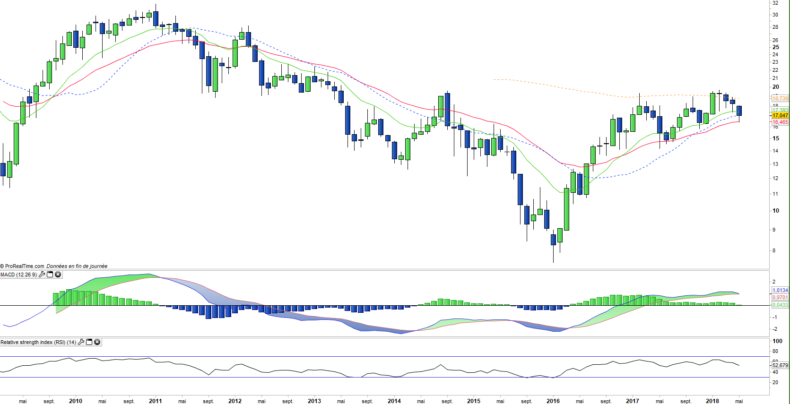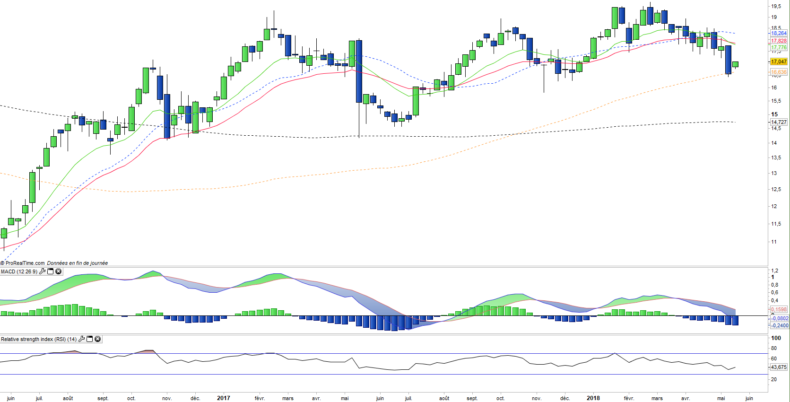Lyxor ETF Brazil Ibovespa - RIO - 23/05/2018
Short Term strategy: Negative (0%) / Trend -
Long Term strategy: Positive (70%) / Trend =
Characteristics of the ETF
The Lyxor RIO ETF (Brazil Index) created in 01/2007,is listed in Euro on Euronext and seeks to replicate the IBOVESPA index which is composed of the 67 main Brazilian stocks, selected according to the size of their market capitalization. This index covers 70% of the Brazilian market capitalization.
The fees of this ETF are 0.65% and the AUM approximately 248M €. Replication is indirect (via Swap) and there is a dividend capitalization policy.
Alternative ETFs: BRZ (Amundi in USD), iShares (EWZ in USD)
Index & components
The RIO (Lyxor) ETF is a very good proxy for the Brazilian economy.
Financials make up 30% of the index, basic materials account for 20%, and energy accounts for only 15%, after Petrobras fell sharply following corruption scandals.
Brazil is the ninth world economy with a GDP of $ 1800bn (the equivalent of Italy). After a period of very strong growth, the economy has been showing signs of slowing down since 2011 because of the stagnation of commodities prices for export, the slowdown in domestic consumption linked to household indebtedness and lower investments.
In 2015 and 2016, the Brazilian economy plunged into recession (-3.5%) and fiscal difficulties increased but the country emerged from the recession in 2017 and is expected to post moderate growth in 2018, the year of the presidential election. The policy continues to punctuate the markets, after the dismissal of Dilma Rousseff, the imprisonment of former President Lula and the corruption scandals around the current President Tremer.
Attempts to adjust the budget and control inflation are on track but need to be deepened. However, with a population of more than 200 million, Brazil also has abundant natural resources and a relatively diversified economy. Brazil is the world's largest producer of coffee, sugar cane and oranges, one of the world's leading soybean producers, and the country attracts many global agribusiness and biofuel groups. Brazil is also a big industrial country. The exploitation of its mineral wealth has made it the world's second largest exporter of iron and one of the largest producers of aluminum and coal. As a producer of oil, Brazil is considering self-sufficiency in short-term energy production (its reserves could make it one of the top five oil producers). The country is becoming increasingly important in the textile, aeronautics, pharmaceuticals, automotive, steel and chemical industries. Most major automobile manufacturers have established production units in the country.
Brazil has emerged from the recession and has strong medium-term growth potential, yet the country remains highly dependent on oil and commodities.
Latest developments
After a rise of nearly 73% in 2016, the rise of the Brazilian index continued in 2017 with a performance of + 10.3%, but recorded a decrease of -1.3% since the beginning of the year 2018, despite the rise in oilprices.
After a historic recession, marked by a slump in GDP of -3.7% in 2015 and -3.5% in 2016, growth returned positive in 2017 to + 1% and could reach 2.5% this year thanks to the positive effects of the monetary policy, with rates halved in eighteen months. However, this fall in key rates corresponds to the rise in US rates, and as a result the US dollar now stands at 3.63 reals, near two years highs. Since January, the Brazilian currency has lost 10% against the greenback. But the need for a further cut in the key rate was strengthened due to the publication of inflation figures below expectations in April. Over one year, inflation stood at 2.76%, below the floor of 3% of the target set by the central bank.
Another factor of uncertainty is the absence of an overtly pro-market candidate in a good position in the five-month polls of the presidential election. Brazil is doing better, but 2018 should be a pivotal year, with the October presidential elections.
Monthly data
The monthly chart shows a long-term trend that remains valid but has undergone quite a sharp correction since March, and shows a strong underperformance compared to other global indices. However moving averages remain up and oscillators remain positive for now. The index arrives on major support (monthly EMA26) that could cause a rebound.
Weekly data
On the weekly chart, we see an important correction that just stumbled on the EMA100, always upward and represents an important support. In the event of a confirmed break, the index would return to a bearish reversal phase. However, it is quite likely that a rebound will be organized from these levels as was the case last year at the same time, amid the context of bullish markets on global equities and oil.
ETF Objective
RIO is a UCITS ETF, listed in €, which seeks to replicate the Ibovespa Brasil Sao Paulo Stock Exchange Index (67 brazilian companies)
Characteristics
| Inception date | 24/01/2007 |
| Expense ratio | 0,65% |
| Benchmark | Ibovespa index |
| Ticker | RIO |
| ISIN | FR0010408799 |
| Currency | € |
| UCITS | Yes |
| EU-SD Status | Out of scope |
| Exchange | Euronext Paris |
| Assets Under Management | 248 M€ |
| Replication Method | Indirect (swap) |
| Dividend | Capitalization |
| PEA (France) | No |
| SRD (France) | Yes |
| Currency risk | Yes |
| Number of Holdings | 67 |
| Risk | 4/5 |
Country Breakdown
| Brazil | 100% |
Sector Breakdown
| Financials | 31% |
| Materials | 20% |
| Energy | 15% |
| Consumer staples | 11% |
| Consumer discretionary | 7% |
| Industrials | 6% |
| Utilities | 4% |
| Others | 7% |
Top Ten Holdings
| Vale | 12% |
| Itau Unibanco | 10% |
| Petrobras - Petroleo Bras-PR | 8% |
| Banco Bradesco | 7% |
| Ambev | 6% |
| Petrobras - Petroleo Bras | 5% |
| BM&FBOVESPA | 3% |
| Itausa investimentos | 3% |
| Banco do Brasil | 3% |
| Ultrapar Participacoes | 3% |


